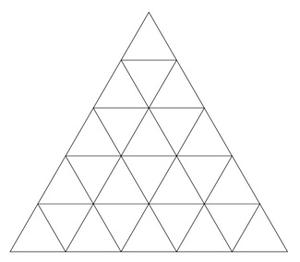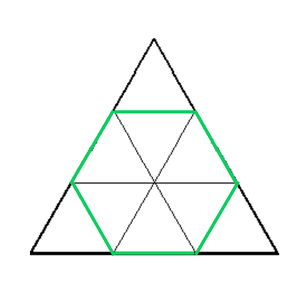Count of Equilateral Triangles of unit length possible from a given Hexagon
Last Updated :
10 May, 2021
Given an array S[] consisting of the lengths of the 6 sides of a Hexagon, the task is to calculate the number of equilateral triangles of unit length that can be made from the given hexagon.
Examples:
Input: S = {1, 1, 1, 1, 1, 1}
Output: 6
Explanation:

Input: S = {2, 2, 1, 3, 1, 2}
Output: 19
Explanation:

Approach: The following observations need to be made to solve the given problem:
- Consider an equilateral triangle of ‘X’ side length. It has been divided into smaller triangles of unit length each, by drawing lines parallel to its sides.
- Below are the images of three such equilateral triangles:

Example 1: X = 2

Example 2: X = 3

Example 3: X = 5
- In each of the above three examples, the count of unit length equilateral triangles possible are:
- X = 2: 4 equilateral triangles of 1 unit length side.
- X = 3: 9 equilateral triangles of 1 unit length side.
- X = 5: 25 equilateral triangles of 1 unit length side.
- By observation, it is clear that, for an equilateral triangle of side length X, X2 equilateral triangles of unit length are possible.
- Extending this observation to Hexagons, inscribe Hexagons inside the equilateral triangles, as shown below:

A regular Hexagon inscribed from equilateral triangle of side X = 3, has 6 mini triangles inside it.

An irregular Hexagon inscribed from the equilateral triangle of side X = 5, has 19 mini triangles inside it.
- It can be observed that by removing a certain number of mini triangles from the bigger triangle, the hexagon with given dimensions can be found.
The formula for counting the number of triangles of unit length can be generalized for a Hexagon having six sides S1 , S2 , S3 , S4 , S5 , S6 as:
Number of triangles that can be formed = ( S1 + S2 + S3 )2 – S12 – S32 – S52
Below is the implementation of the above approach:
C++
#include <bits/stdc++.h>
using namespace std;
int calculateTriangles(int sides[])
{
double count = pow(sides[0] + sides[1] +
sides[2], 2);
count -= pow(sides[0], 2);
count -= pow(sides[2], 2);
count -= pow(sides[4], 2);
return (int)(count);
}
int main()
{
int sides[] = { 1, 1, 1, 1, 1, 1 };
cout << (calculateTriangles(sides)) << endl;
int sides1[] = { 2, 2, 1, 3, 1, 2 };
cout << (calculateTriangles(sides1)) << endl;
return 0;
}
|
Java
import java.util.*;
class GFG{
static int calculateTriangles(int sides[])
{
double count = Math.pow(sides[0] + sides[1] +
sides[2], 2);
count -= Math.pow(sides[0], 2);
count -= Math.pow(sides[2], 2);
count -= Math.pow(sides[4], 2);
return (int)(count);
}
public static void main(String[] args)
{
int sides[] = { 1, 1, 1, 1, 1, 1 };
System.out.print((calculateTriangles(sides)) + "\n");
int sides1[] = { 2, 2, 1, 3, 1, 2 };
System.out.print((calculateTriangles(sides1)) + "\n");
}
}
|
Python3
def calculateTriangles(sides):
count = pow( sides[0] + sides[1] + sides[2], 2)
count -= pow( sides[0], 2)
count -= pow( sides[2], 2)
count -= pow( sides[4], 2)
return int(count)
sides = [1, 1, 1, 1, 1, 1]
print(calculateTriangles(sides))
sides = [2, 2, 1, 3, 1, 2]
print(calculateTriangles(sides))
|
C#
using System;
class GFG{
static int calculateTriangles(int []sides)
{
double count = Math.Pow(sides[0] + sides[1] +
sides[2], 2);
count -= Math.Pow(sides[0], 2);
count -= Math.Pow(sides[2], 2);
count -= Math.Pow(sides[4], 2);
return (int)(count);
}
public static void Main(String[] args)
{
int []sides = { 1, 1, 1, 1, 1, 1 };
Console.Write((calculateTriangles(sides)) + "\n");
int []sides1 = { 2, 2, 1, 3, 1, 2 };
Console.Write((calculateTriangles(sides1)) + "\n");
}
}
|
Javascript
<script>
function calculateTriangles(sides)
{
let count = Math.pow(sides[0] + sides[1] +
sides[2], 2);
count -= Math.pow(sides[0], 2);
count -= Math.pow(sides[2], 2);
count -= Math.pow(sides[4], 2);
return (count);
}
let sides = [ 1, 1, 1, 1, 1, 1 ];
document.write((calculateTriangles(sides)) + "<br/>");
let sides1 = [ 2, 2, 1, 3, 1, 2 ];
document.write((calculateTriangles(sides1)) + "<br/>");
</script>
|
Time Complexity: O(1)
Auxiliary Space: O(1)
Share your thoughts in the comments
Please Login to comment...